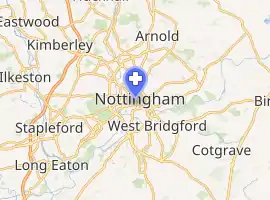Nottingham General Hospital
Nottingham General Hospital was a major hospital in Nottingham, England. It was founded in 1781 and closed in 1992.
| Nottingham General Hospital | |
|---|---|
 Nottingham General Hospital with the main hospital block (facing) and the Jubilee Wing (on the right) | |

| |
 Location within Nottinghamshire | |
| Geography | |
| Location | Nottingham, Nottinghamshire, England, United Kingdom |
| Coordinates | 52°57′06″N 1°09′22″W |
| Organisation | |
| Care system | NHS England |
| Type | General Hospital |
| History | |
| Opened | 1781 |
| Closed | 1992 |
| Links | |
| Lists | Hospitals in England |
History


The hospital was the result of a legacy from John Key, a wealthy banker, who had left money in his will for hospitals to be built in Nottingham and York.[1] The site selected for the hospital in Nottingham was part of the area known as Nottingham Park, immediately to the north of Nottingham Castle and near the wharves: one half of the land was given by Thomas Pelham-Clinton, 3rd Duke of Newcastle for the purpose and the other half by the town corporation.[2]
The foundation stone for the first building, which had been designed by John Simpson, was laid on 12 February 1781 and the hospital opened with 44 beds in September 1782.[2][3] John Wesley, the theologian, was an early visitor to the hospital.[4]
The hospital was extended with the Derbyshire wing, financed by a large donation from Henry Cavendish,[5][6] which opened in 1787.[3]
In 1844 the hospital had to respond to a major disaster when 12 people were killed and over a hundred injured when a stand collapsed at a public hanging on Garner's Hill.[7]
A design for a third storey for the original building was developed by Thomas Chambers Hine and the works completed in 1855.[3][7] Another new wing on the Park Row frontage opened in 1879, and the Jubilee Wing, designed by Alfred Waterhouse in a circular shape to celebrate Queen Victoria's Diamond Jubilee, opened in 1900.[3][8]
During the First World War 102 beds were made available to the Government for wounded soldiers.[9]
The Nurses Memorial Home was opened by the Prince of Wales in 1923 as a monument to the soldiers of Nottinghamshire who had died in the First World War.[3] Extensions financed by donations from William Goodacre Player included the Ropewalk Wing opened by Princess Mary in 1929,[10] the Player Wing opened in 1932[11] and the Castle Ward, designed by Evans, Clark and Woollatt,[12] which opened in 1943.[3][13]
In 1948, at the formation of the National Health Service, the hospital came under the Sheffield Regional Hospital Board.[3] The hospital comprised 423 beds at that time.[3] The Intensive Care Unit was completed in 1963 and the Trent Wing was opened by Sir Keith Joseph in 1972.[3][14] After services had transferred to the Queen's Medical Centre, the hospital closed in 1992.[3] The main hospital block is now home to the offices of Nottingham City Clinical Commissioning Group and Nottingham CityCare Partnership.[15]
References
- Mitchell, Professor Tony. "The Story of the General Hospital". Retrieved 9 October 2018.
- Bittiner and Lowe, p. 8
- "Nottingham General Hospital". Manuscripts and Special Collections, University of Nottingham. Retrieved 11 September 2016.
- Bittiner and Lowe, p. 9
- Chambers, Hine Thomas (1876). Nottingham, Its Castle, a Military Fortress, a Royal Palace, a Ducal Mansion, a Blackened Ruin, a Museum and Gallery of Art. Hamilton, Adams and Co. p. 35. ISBN 9781145255685.
- Bittiner and Lowe, p. 15
- Bittiner and Lowe, p. 19
- Bittiner and Lowe, p. 21
- Bittiner and Lowe, p. 24
- Bittiner and Lowe, p. 27
- Bittiner and Lowe, p. 29
- "New Ward for Hospital". Nottingham Journal. England. 1 April 1942. Retrieved 5 March 2018 – via British Newspaper Archive.
- Bittiner and Lowe, p. 32
- Bittiner and Lowe, p. 44
- "Standard Hill and Postern Street". Nottinghamshire History. Retrieved 9 October 2018.
Sources
- Bittiner, John Bruce; Lowe, David (1990). Nottingham General Hospital - Personal Reflections (PDF). Nottingham: Special Trustees for Nottingham University Hospitals.